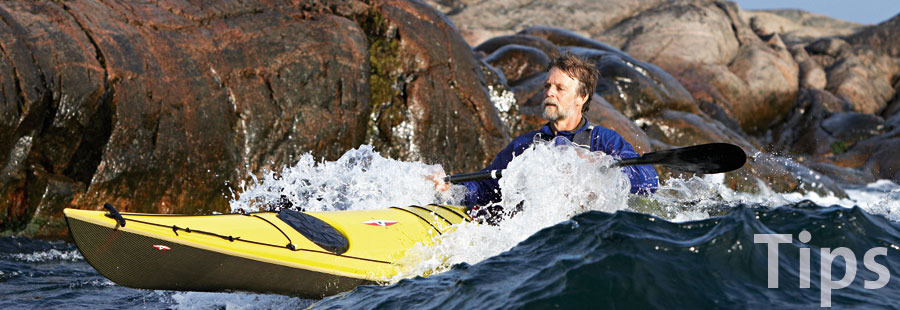|
Accidental damages to the gel-coat should therefore be repaired as soon as possible to prevent structural weakness sustained over time by moisture creeping into the fibreglass laminate. It is easy to repair the gel-cot, and if you use the right procedures and materials, the repair will be impossible to detect afterwards. |
|
You will need the following materials to repair your kayak: 2. Sanding block 3. Wet sandpaper of the following thicknesses: 400, 600, 800, 1000 and 1200. (If you are unsure, your local hardware store or marine supply store will be able to guide you.) 4. Thin brush 5. A sharp knife 6. Polishing paste (such as Autosol chrome polish) 7. White Gel-coat putty/filler (such as plastic padding) - A small spatula - Clean rags - A bowl of water - An hour of your time |
|
Procedure 1. Start out by making sure that the damaged area is clean and dry. Scrape away any possible dirt from the edges with a sharp knife, sanding machine with a sharp edge or scalpell. Clean the damged area with acetone on a clean rag. This will both clean and dry out the last moisture from the damaged area, and improves the conditions to attach the new gel-coat to the surface. |
|
2. Mix the gel-coat according to the product instructions. On rule that applies to polyester products is that the more hardener is used the quicker it will harden. A normal ratio is 3%. Brush the gel-coat on the damaged area. Be sure to apply the gel-coat especially well to the edges of the damage. Apply the bulk of the gel-coat with the spatula and let it harden. The damage is now sufficiently repaired to be able to use the kayak again, but if you want the damage to be invisible, you will need to continue with the instructions below. |
|
With the 400 paper you’ll sand away the surplus material and shape the right form. You will now know if you have used enough gel-coat to repair the damage. If nor you will have to dry out the area, clean it with acetone and start over. WARNING – the gel-coat is only 1-2mm thick on the kayak, so it is easy to sand through to the fibreglass if you are not careful. |
|
Now that you’re finished with the sanding it is time to polish the area to it’s former glory. Use a polishing machine or brute handpower together with polishing paste. Wash and dry. At this point the initial damage should be repaired and impossible to distinguish from the rest of the kayak. Good Luck! |

Learn how to repair gel-coat damages
Publicerad: 2010.01.01
Uppdaterad: 2013.03.08
Gel-coat is the material which is used to create the glossy colored finish on the hull and deck.
News
» [25/02/2015]
Boblbee becomes Point 65 Sweden!
Boblbee has become a part of Point 65 Sweden and the awesome product line has been re-launched under the Point 65 Sweden brand.
Read more »
Boblbee becomes Point 65 Sweden!
Boblbee has become a part of Point 65 Sweden and the awesome product line has been re-launched under the Point 65 Sweden brand.
Read more »
» [22/05/2014]
Q&A with adventure paddler James Cox
Paddling around Sweden in a Point 65 FREYA 18
Read more »
Q&A with adventure paddler James Cox
Paddling around Sweden in a Point 65 FREYA 18
Read more »
» [16/10/2013]
Nigel Foster opens US online kayak store
Legendary kayaker Nigel Foster opens an online kayak store offering Point 65's full range of modular kayaks and the accessories you need. Nigel can ship anywhere in the US (lower 48 states) and offers same/next day shipping and competitive prices.
Read more »
Nigel Foster opens US online kayak store
Legendary kayaker Nigel Foster opens an online kayak store offering Point 65's full range of modular kayaks and the accessories you need. Nigel can ship anywhere in the US (lower 48 states) and offers same/next day shipping and competitive prices.
Read more »
» [04/09/2013]
Sail & Surf appointed Austrian distributor for Point65!
Great news! SAIL & SURF has been appointed the Point 65 distributor for Austria. Come spring 2014 Sail & Surf will hold significant inventory of our modular kayaks. So Austrian dealers will now have product easily available.
Read more »
Sail & Surf appointed Austrian distributor for Point65!
Great news! SAIL & SURF has been appointed the Point 65 distributor for Austria. Come spring 2014 Sail & Surf will hold significant inventory of our modular kayaks. So Austrian dealers will now have product easily available.
Read more »
Point 65 Packs
Boblbee has become a part of
Point 65 Sweden and the
awesome product line has
been re-launched under the
Point 65 Sweden brand.
Check out Point 65 Packs!
packs.point65.com
Point 65 Sweden and the
awesome product line has
been re-launched under the
Point 65 Sweden brand.
Check out Point 65 Packs!
packs.point65.com







